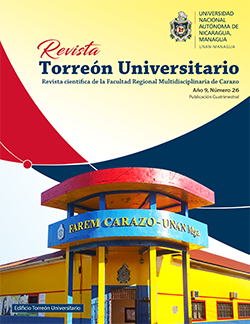Topographic Position Index (TPI) to identify floodable areas and zoning of plant species in a mangrove swamp in the South Pacific of Nicaragua
DOI:
https://doi.org/10.5377/torreon.v9i26.10264Keywords:
TPI, mangrove forest, geomorphology, flooding areas, integrated managementAbstract
COP7 recognized that mangroves are vulnerable ecosystems and threatened by habitat loss and degradation, which need urgent actions to guarantee their conservation and rational use. Geomorphological and hydrological processes are key to the growth and development of mangrove forests. However, in Central America, very few studies exist in this regard. Mangrove forests offer valuable economic and ecological services, such as tourism and shelter for species of flora and fauna. Furthermore, they protect against sea-level rise caused by climate change. The hydrology of the mangrove swamp of Río Ostional, in the South Pacific of Nicaragua, has been studied in recent years suggesting a relationship between mangrove species and freshwater inputs. In this project, the use of the Topographic Position Index (TPI) was explored to identify small-scale floodplains with little variation in elevation in a mangrove swamp. For this, a geomorphological characterization was carried out through a detailed topographic survey of the area and the analysis of the TPI as a method of classifying landforms to identify the flood zones; as well as the zoning of plant species. The classification of the TPI was related to the zoning of species. This relationship will allow the identification of the most sensitive areas to geomorphological modifications of possible anthropic origin, which is an essential input for comprehensive forest management.
Downloads
Downloads
Published
How to Cite
Issue
Section
License
The authors who publish in this journal agree to the following terms.
- The author or authors of the articles, essays or research grant the National Autonomous University of Nicaragua, Managua (UNAN-Managua) the editing rights (copyright) of the submitted work, therefore the University has the exclusive right to publish the article for the entire copyright period.
- These copyrights/authors authorize Torreón Universitario Magazine and the University to edit and disseminate/publish the article in said Magazine, including printed and electronic reproduction, storage, retrieval and any other type of publication, and sources of secondary information as services. of summaries and databases, they also empower it to protect the article against unauthorized use for dissemination by printed or electronic media (PDF, HTML, EPUB, XML or others).
License for use of content
The magazine uses the Creative Commons Attribution-NonCommercial-NoDerivs 4.0 International License.
Under this statement:

This journal is licensed under a Creative Commons Attribution-NonCommercial-NoDerivatives 4.0 International License. It can be copied, distributed and transmitted publicly as long as the author and source are cited (Revista Torreón Universitario), it should not be modified or used for any commercial purpose. The full license can be found at http://creativecommons.org/licenses/by-nc-nd/4.0/.



